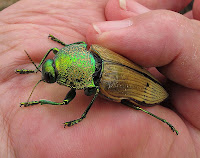Temognatha chevrolati – Large Jewel Beetles 2
These spectacular iridescent beetles were in their hundreds when I encountered them feeding and mating in flowering Eucalyptus perangusta, primarily around Lake Tay 140 km (85 miles) NW of Esperance and in company with many other large Jewel Beetle species.
These mass occurrences are recorded happening spasmodically across the country in mallee country during the hottest months of the year (January to March), often years apart and I just happened to be in the right place at the right time. I had been investigating on a monthly basis the vegetation of the Lake Tay region and only encountered these large Jewel Beetles during the month of February, interestingly none were observed the month before or after.
Temognatha chevrolati are around 5 cm (2”) in length and were the most plentiful of the larger Jewel Beetle species; they were also the most active and alert too, quickly taking flight the moment the camera was pointed in their direction, only mating couples were placid enough to be approached. Because of this skittishness (although not aggressive and with no attempt to bite), I was forced to grab and hold individuals to photograph and that is why there is usually a finger or thumb being used as a restraint in the above photographs.
When released, almost immediately up would go the hardened wings of the elytra and with the frantic beating of the membranous wings beneath, they would with a monstrous buzzing sound take flight. I might add that this action although appearing laboured, was always faster than I could click the shutter to record it digitally. They would seldom fly far, only to suddenly plummet out of sight into more eucalypt blossom.
Temognatha chevrolati is only found in WA, with Hyden and Lake Grace being central to their distribution; Lake Tay is around 120 km (75 miles) further east and as this region is more remote and largely inaccessible, would probably also be an important stronghold for this species.
The genus Temognatha has previously been known as Stigmodera and Themognatha and belongs to the Buprestidae family.
My thanks to Kim Pullen of the Australian National Insect Collection, CSIRO Ecosystem Sciences who kindly confirmed the identity this species.







